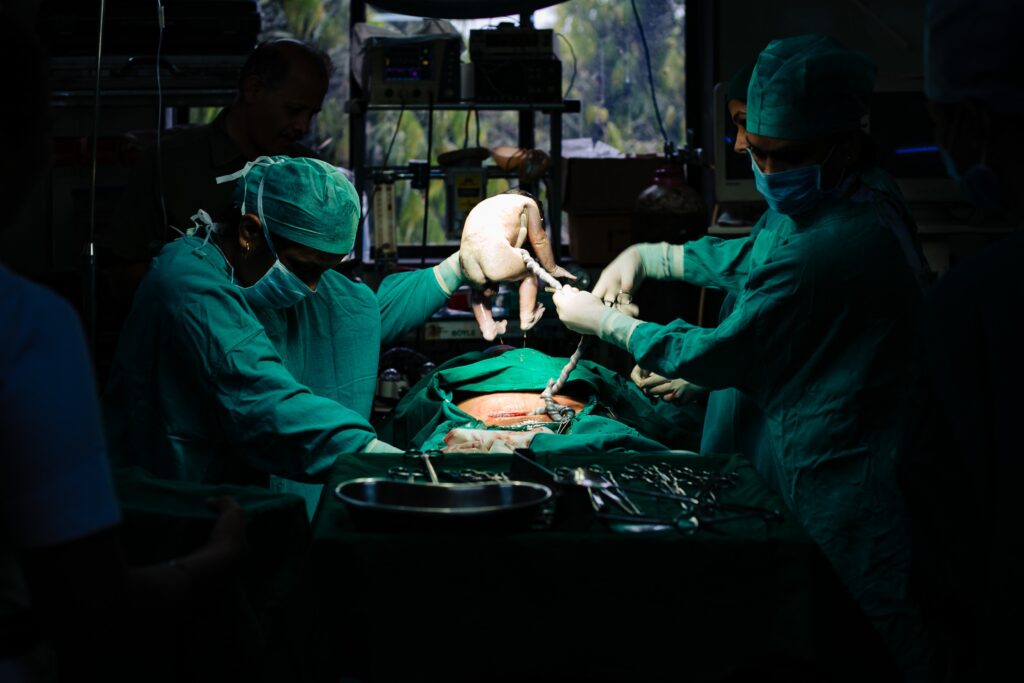News Team member Alexa Morales describes the need for new prenatal nutrition guidance to include fiber, as it promotes stronger microbiomes and better health outcomes in mothers and their babies.

By Jocelyn Spizman
Babies born by Cesarean-section are at a higher risk of developing asthma and allergies.[8] This is partly explained by the relationship between mode of delivery and the baby’s microbiome.[2,8]
Babies born naturally are exposed to their mother’s fecal microbiome and tend to carry these Bacteroides strains into their gut. Children that are born by Cesarean do not receive these vital microbes from their mother and display a microbiome that largely reflects opportunistic bacteria, such as Enterococcus, Enterobacter, and Klebsiella, from the hospital environment in which they are born.[2]

Mode of delivery is the first determinant in which all neonatal and infant gut microbes are established. Later lack of exposures, such as formula feeding and antibiotics, continues to build the microbiome, which protects young babies against infections.[4] During a C-section, mothers tend to receive intravenous antibiotics due to the risks of infection and these antibiotics cross the placenta to the baby. Further, as a result of the mother’s recovery period necessary after surgery, babies are also less likely to begin breastfeeding and are more likely to get started on formula.[2]
The Connection to Allergies & Asthma
The mediating variable is hypothesized to be the interconnected gut microbiome and immune system. With the proper gut microbes, babies can properly digest nutrients and expand and establish their immune system. With an increase in C-sections in recent decades, this new finding could explain why allergy and asthma rates are so remarkably high and increasing over time.[5,6,8] According to the CDC, rates of asthma in the U.S. have grown 28% to now include around 25 million people.[1]
Besides C-sections, the main factors contributing to increasing allergy and asthma rates is the way children are being raised inside their homes without enough outdoor exposures. According to the American Academy of Allergy, Asthma, and Immunology, the “hygiene hypothesis” suggests that the living conditions for children are too clean. Children should be exposed to endotoxins, which are germ and germ components that stimulate healthy early responses in the immune system.[10] Without these fundamental exposures, children’s immune systems become overly sensitized and unprepared. Conditions such as antibiotics and obesity further contribute to the increasing rates of allergies and asthma.

Although the C-section procedure was originally, and still is, a life saving procedure that is done out of necessity, this past paradigm has shifted from necessity to preference. More and more women and healthcare providers prefer the surgery due to the decreasing risk of complications, increased predictability, and decreased birthing pain for the mother that is expected from vaginal birth.[7] This modernization of birth has its faults. Implications of a C-section must be publicized to expecting mothers so that they can make well informed decisions about the future health of their baby.
For those that have to do a C-section, there are steps you can do to care for your baby’s biome after birth. Dousing or dabbing your baby with maternal bottom swabs shared with the baby soon after birth can help spread the missed microbes, although there are many healthcare providers who do not support this practice due to the risk of transmitting pathogenic bad bacteria.[3,4,9] Other options include prioritizing breastfeeding, which transfers important nutrients as well as using baby probiotics.[9] Some parents wait to give their baby their first bath so that they are exposed to endotoxins early which stimulate the development of a healthy microbiome and immune system.[4]
A baby’s first exposure to the world is important and C-section deliveries are not without consequences. Before jumping to the procedure, expecting mothers should talk to their healthcare team about other options.
References:
- ASTHMA FACTS CDC’s National Asthma Control Program Grantees [Pamphlet]. (2013). Atlanta, GA: Center for Disease Control and Prevention.
- Callaway, E. (2019, September 18). C-section babies are missing key microbes. Retrieved October 14, 2020, from https://www.nature.com/articles/d41586-019-02807-x
- Dominguez-Bello, M. G., Jesus-Laboy, K. M., Shen, N., Cox, L. M., Amir, A., Gonzalez, A., . . . Clemente, J. C. (2016). Partial restoration of the microbiota of cesarean-born infants via vaginal microbial transfer. Nature Medicine,22(3), 250-253. doi:10.1038/nm.4039
- Hamzelou, J. (2019, September 18). C-section babies have a different microbiome – but not for long. Retrieved October 14, 2020, from https://www.newscientist.com/article/2216818-c-section-babies-have-a-different-microbiome-but-not-for-long/
- Juarez, D. (2014, September 02). Asthma and Allergies on the Rise in the U.S. Retrieved October 14, 2020, from https://www.healthline.com/health-news/children-allergies-and-asthma-on-the-rise-110813
- Moore, A. (Ed.). (2020, September 28). Increasing rates of allergies and asthma: AAAAI. Retrieved October 14, 2020, from https://www.aaaai.org/conditions-and-treatments/library/allergy-library/prevalence-of-allergies-and-asthma
- Osterman, M. J., & Martin, J. A. (n.d.). Trends in Low-risk Cesarean Delivery in the United States, 1990—2013 (United States, Center for Disease Control and Prevention, Vital Statistics).
- Shao, Y., Forster, S. C., Tsaliki, E., Vervier, K., Strang, A., Simpson, N., . . . Lawley, T. D. (2019, September 18). Stunted microbiota and opportunistic pathogen colonization in caesarean-section birth. Retrieved October 14, 2020, from https://www.nature.com/articles/s41586-019-1560-1
- Silver, N. (2019, February 13). Baby Probiotics: Are They Safe? (K. Gill M.D., Ed.). Retrieved October 14, 2020, from https://www.healthline.com/health/probiotics-and-digestive-health/baby-probiotics
- What is the Hygiene Hypothesis? [Video file]. (2014, May 21). Retrieved October 14, 2020, from https://www.youtube.com/watch?v=akw6XfexNas&feature=youtu.be

